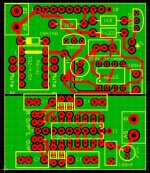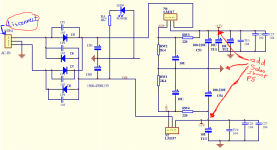Its alright because it is still under 100C in the chip core. That is kind of a safe service barrier. 71C + (3.5W times 6.4 RthH) = 93.4C. It breaks at 150C in there. Its just that the less C the better the chances for very long service life.
Its alright because it is still under 100C in the chip core. That is kind of a safe service barrier. 71C + (3.5W times 6.4 RthH) = 93.4C. It breaks at 150C in there. Its just that the less C the better the chances for very long service life.
Thanks,
5 cm legs for the mosfet do not sound appealing ? My only concern is this device will be powered 24/7
Regards,
Davide
I've been thinking of mounting the mosfets to the bottom plate of the chassis for heat sinking.
Thanks,
5 cm legs for the mosfet do not sound appealing ? My only concern is this device will be powered 24/7
Regards,
Davide
60C rule of thumb would be a measure to never fail due to thermal design that could have been much better. 80C for 24/7 operation would be the red safe line in this occasion I would say, so 71C on the 9610's body its not the end of the world. Keep a spare of this inexpensive MOSFET for when it fails after years. Just not after very many years. If when it ever fails powering the client circuit means not creating any other system disaster don't worry too much.
I've been thinking of mounting the mosfets to the bottom plate of the chassis for heat sinking.
We do that many times. Just measure the semiconductors body temperatures, and check with their RthC spec for no more than 100C internally but always try for 80C or less in the chip core when you can.
Pdiss of CCS is < (12V-5V) * 0.5A = <3.5W
What's the problem?
A bit is dropped in the resistor, so a sink of 7C/W would rise by less than 25Cdegrees.
What's the problem?
A bit is dropped in the resistor, so a sink of 7C/W would rise by less than 25Cdegrees.
Salas I'm powering with Reflektor D a Flip Flop with LP filter to listen DSD without DAC but I'm getting high white noise mixed with the signal & I read some people is related to the PSU, that's the reason I ask your help.
Attached schematic of Flip Flop.
I'm only using the Flip Flop & LP filter, my system is Amanero USB-I2S + DIYINHK i2s ISOLATOR, Amanero is powered with BiB & the I2S isolator & the Flip Flop + LP filter is powered with the Reflektor D.
Actually I'm using only the LP filter direct from the isolator with any kind of noise and I'm very happy, I have tried Flip Flop to have more gain.
TIA
Felipe
Attached schematic of Flip Flop.
I'm only using the Flip Flop & LP filter, my system is Amanero USB-I2S + DIYINHK i2s ISOLATOR, Amanero is powered with BiB & the I2S isolator & the Flip Flop + LP filter is powered with the Reflektor D.
Actually I'm using only the LP filter direct from the isolator with any kind of noise and I'm very happy, I have tried Flip Flop to have more gain.
TIA
Felipe
Attachments
Last edited:
There is not particularly high inherent hiss in the Ref-D so look if its a product of oscillations by using your scope on the rails. If it is, try the two wire output alternative.
Salas can the Flip Flop generates white noise?
I ask because when I use only the LP filter without the flip flop using always de Reflektor-D I don't hear any noise.
I ask because when I use only the LP filter without the flip flop using always de Reflektor-D I don't hear any noise.
Last edited:
I extracted some information from the thread "The best DAC is no DAC" http://www.diyaudio.com/forums/digital-line-level/273474-best-dac-no-dac.html
DF96 posted
In either case you need a good supply rail for them, as you are listening to the supply rail modulated by the final gate
benb posted
As far as terminology, the 74HC74 as used is arguably a "dual 1-bit DAC", and indeed a good power supply is critical because the PSRR here is 0 dB. Any variation of the 74HC74 Vcc line directly modulates the output.
peufeu posted
Of course since your DAC is basically a logic gate, and its output is the product of its power supply and the digital value, it means you have to use a balanced output... for example you can use a 74HC flop with normal and inverting output. It should have a very clean power supply...
DF96 posted
You will still get noise IM, as it is the supply rail which sets the voltage gain of the output stage. The rail must be very clean, probably cleaner than usually required for normal analogue stages. Normal analogue stages have their gain loosely set by the supply rail; this analogue stage (yes, it is an analogue stage even though it uses 'digital logic') has its gain set directly by the supply rail.
DF96 posted
In either case you need a good supply rail for them, as you are listening to the supply rail modulated by the final gate
benb posted
As far as terminology, the 74HC74 as used is arguably a "dual 1-bit DAC", and indeed a good power supply is critical because the PSRR here is 0 dB. Any variation of the 74HC74 Vcc line directly modulates the output.
peufeu posted
Of course since your DAC is basically a logic gate, and its output is the product of its power supply and the digital value, it means you have to use a balanced output... for example you can use a 74HC flop with normal and inverting output. It should have a very clean power supply...
DF96 posted
You will still get noise IM, as it is the supply rail which sets the voltage gain of the output stage. The rail must be very clean, probably cleaner than usually required for normal analogue stages. Normal analogue stages have their gain loosely set by the supply rail; this analogue stage (yes, it is an analogue stage even though it uses 'digital logic') has its gain set directly by the supply rail.
You got a squeaky clean line with the dummy but I can see some modulation on the first picture. Use two wire mode and JFET instead of R6 to see if it gets any better or its just the logic gate noise propagating on the rail.
Can works better the BiB if as posted DF96 saying is an "analog stage"?
If you get no better result with 2wire and JFET mod try the bib in 2wire also
Substitute LM317 / 337 'in circuit'
Hi Salas & others,
I would like to substitute the LM317/337 in a DAC with a Salas Shunt - just as a quick trial - without removing the LM317/337 in the circuit
If I disconnect the ac power to the LM317/337, leaving the inputs to the 317/337 'floating', and connect +15v/0v/-15 on the LM317/337 outputs, am I likely to cause damage to the LM317/337 or any unexpected / unwanted effects ?
diagram attached.
Thx !
Hi Salas & others,
I would like to substitute the LM317/337 in a DAC with a Salas Shunt - just as a quick trial - without removing the LM317/337 in the circuit
If I disconnect the ac power to the LM317/337, leaving the inputs to the 317/337 'floating', and connect +15v/0v/-15 on the LM317/337 outputs, am I likely to cause damage to the LM317/337 or any unexpected / unwanted effects ?
diagram attached.
Thx !
Attachments
- Status
- Not open for further replies.
- Home
- Amplifiers
- Power Supplies
- The simplistic Salas low voltage shunt regulator


